The titular attraction of the series: the roller coaster. These attractions consist of a railroad track, wooden or metal, with small cars or trains running on them. The tracks can have many turns, twists, drops, and loops depending on the type of coaster, but all of them provide a lot of enjoyment for guests and are the best way to lure in new guests next to advertising. Most roller coasters are complex and require thoughtful planning to ensure they're well-designed: managing G-Forces, having a lot of drops, keeping speed high, and if possible, adding loops and corkscrews. Roller coasters are also the most dangerous of all ride types as nearly every coaster is capable of killing customers by crashing into another train too fast or for a select few, flying off the track by taking hills too fast. Coasters are also the most expensive to build, ranging from $1,000+ to $4,000+ in approximate costs. Despite all that, a well-built coaster is more than worth it, even required to make a lot of cash and bring in a lot of guests.
Air Powered Vertical Coaster[edit]

Cost: $6,750 upwards
Max Height: None
Max Track Slope: 90°
Special Pieces: Banked Turns, Brakes, Level to Vertical, Top Section, Vertical to Level
Ride Modes: Powered Launch Mode
Appearance: Loopy Landscapes
A steel coaster with massive supports and air-powered trains on rubber tires that are launched at high speeds. This coaster is usually built with very simple designs as elevating the track is only done by going straight up, over a small crest, then straight back down. Since there are no chain lifts and the track is required to go straight up and down, the coaster only functions in powered launch mode at very high speeds: from 67 mph (107 kmh) to 112 mph (180 kmh). With high speeds and large drops, all three main stats will end up high, especially intensity.
It's very easy to go overboard on intensity with this ride since even the lowest speed setting is powerful. A good Air Powered Coaster requires the car to go over the crest of the hill with barely enough speed. If the car takes the hills too fast, it will create excessive vertical G's. Also ensure all turns are banked to keep lateral G's reasonable. One drop is enough to satisfy guests, but you can add more if you want. However, be careful going overboard as this coaster type is very expensive to construct.
Bobsled Roller Coaster[edit]

Cost: $2,700 upwards
Max Height: 78 ft (24 m)
Max Track Slope: 25°
Special Pieces: Banked Turns, Helices, S-Bends
Ride Modes: Continuous Circuit Mode
Appearance: RollerCoaster Tycoon
Similar to the Water Slide, the Bobsled Roller Coaster consists of semi-circular track supported by steel posts. The cars are bobsleds that run on small wheels, following along the curve of the track. This coaster excels at providing lateral G's for rides with its sharp curved turns and large helices; incorporating tons of them as well as drops are needed to give riders that feeling of nearly but not quite falling off the track. However, even though the bobsled doesn't fall off on turns, it does if it takes the crests of hills too fast.
A good Bobsled Coaster needs to have its speed carefully managed. Ensure that the cars don't take the hill at 31 mph (50 kmh) or more. It's recommended to not have small bumps after a big drop as that'll easily cause a derail. Instead, add upward helices as the sled will never fly off while giving the coaster more space for additional drops. Stats for the Bobsled Coaster can be pretty low with excitement and intensity ratings hovering around 5, so use every excitement bonus possible to get it around the mid-5s. Stacking helices in a upward or downward coil is one way to earn more excitement.
Flying Roller Coaster[edit]

Cost: $4,000 upwards
Max Height: 111 ft (34 m)
Max Track Slope: 60°
Special Pieces: Banked Turns, Brakes, Half Corkscrew, Half Loop, Helices, In-Line Twist, On-Ride Photo, S-Bends, Steep Turns, Vertical Loop
Ride Modes: Continuous Circuit Mode
Appearance: Corkscrew Follies
Not to be confused with a different Flying Roller Coaster in RollerCoaster Tycoon 2, this version has a tubular track with cylindrical posts. The trains have their wheels below and inside the rails with guests seated in a lying-down position. This gives the coaster a unique characteristic where half inversions like twists and corkscrews do not immediately need the other half, allowing the train to ride upside down. However, the track must eventually flip back in order to connect to the station.
The Flying Coaster has many inversion types and since half inversions don't need to be connected to another, you have more flexibility with where you can place corkscrews, twists, and half loops. You can use this to your advantage if there's less space for the coaster to have a full inversion. The upside-down pieces are just as flexible as the right side up ones as you can even place brakes, on-ride photo sections, and station platforms upside down. Overall, a useful coaster with good stats even if it's rather pricey and its max height is lower than some of its other steel contemporaries.
Heartline Twister Roller Coaster[edit]

Cost: $3,030 upwards
Max Height: 95 ft (29 m)
Max Track Slope: 60°
Special Pieces: Heartline Roll, Lower Transfer, Upper Transfer
Ride Modes: Continuous Circuit Mode
Appearance: Corkscrew Follies
One of two coasters that are built as a straight line, the Heartline Twister Roller Coaster has tubular rails running through steel hoops. The cylindrical twister cars move along the rails and hold up to 4 people. To keep everything in a straight line, the cars are shifted upward and downward by transfer pieces instead of turning around by corners. There's also two Heartline Rolls that spins the car clockwise or counterclockwise. To keep things compact, the chain lift can be placed on steep pieces as well as gentle pieces.
Although the little space it takes up is a big plus, the excitement rating it provides is terrible as most designs end up around 2-3 while intensity and nausea are at more standard levels. Furthermore, the Heartline must at least have one roll or it's excitement rating gets divided by 4. It's only recommended to build this if you're low on space or you've literally built every other coaster available in the level.
Inverted Roller Coaster[edit]
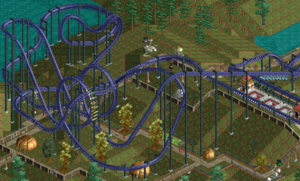
Cost: $4,100 upwards
Max Height: 183 ft (56 m)
Max Track Slope: 60°
Special Pieces: Banked Turns, Brakes, Half Corkscrew, Half Loop, Helices, In-Line Twist, Large Half Loop, On-Ride Photo, S-Bends, Steep Turns, Vertical Loop
Ride Modes: Continuous Circuit Mode, Powered Launch Mode
Appearance: RollerCoaster Tycoon
A steel coaster with square, shaped track with running rails connected, the trains are placed below the track with the wheels above and below said rails. The ride gives guests a more intense feeling as their legs are dangling in the air with no car surrounding them, only held by over-the-shoulder restraints and a seat. Trains usually hold two people per car, but Loopy Landscapes adds a 4-seat coaster for larger guest throughput. To keep the inverted nature of it, there are a lot of special pieces like corkscrews, loops, helices, and twists.
Stats for the Inverted Coaster have good excitement ratings and equally high intensity ratings. However, the nausea is also pretty high as expected for these suspended-type coasters. Even a small powered launch coasters can end up with a nausea rating in the high 5s. Make sure a handyman is stationed near the exit to mitigate puke. Other than that, it is an excellent, but expensive coaster to use for thrill-seeking guests. It's recommended to put at least one high, steep drop to help the cars speed through the inversions and inclines.
Inverted Wild Mouse Coaster[edit]
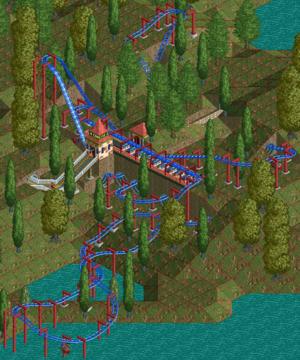
Cost: $2,000 upwards
Max Height: 68 ft (21 m)
Max Track Slope: 60°
Special Pieces: Brakes
Ride Modes: Continuous Circuit Mode
Appearance: Loopy Landscapes
One of the three wild mouse coasters in the game, the Inverted Wild Mouse is a compact coaster with tiny turns and steep lift hills available. The track is completely tubular with cars hanging under the track by wheels. Strangely, these cars are not rodent shaped at all, but they function the same as a Steel Wild Mouse: no trains and only four cars per passenger.
Tight turns and sudden drops are mandatory to give this coaster the G-forces it needs. However, it can be easy to suddenly have the intensity rating shoot up if the cars take corners too quickly. Thankfully, this version does have brakes, so use them to manage lateral G's. As for sudden drops, be sure to have at least one steep drop as well or the stats will get penalized harshly.
Mine Train Roller Coaster[edit]
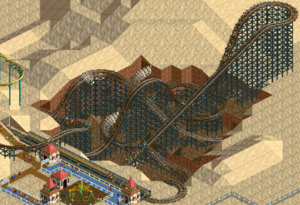
Cost: $3,050 upwards
Max Height: 68 ft (21 m)
Max Track Slope: 60°
Special Pieces: Banked Turns, Brakes, Helices, On-Ride Photo, S-Bends
Ride Modes: Continuous Circuit Mode
Appearance: RollerCoaster Tycoon
Always fitting for a prospector theme, the Mine Train Roller Coaster has steel rail track over rickety-looking wooden boards and supports. The trains themselves are shaped like coal-powered locomotives, but can handle speeds much faster than them. Along with that, the turns and helices are very slanted, making it a ride that can really make guests lean.
Its low support limit can make it tricky to work with, but overall, Mine Train Coasters are one of the easier types to build. A single steep drop and tons of helices are key to making this work. Although not required, it's also a coaster that's most suitable for tunnels, which can add a decent bonus to excitement. The building cost is pretty expensive compared to other wooden coasters, but not by much, so it shouldn't break the bank unless you're going for an epically long ride.
Reverse Whoa Belly Roller Coaster[edit]
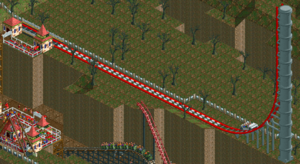
Cost: $6,750 upwards
Max Height: None
Max Track Slope: 90°
Special Pieces: Level to Vertical
Ride Modes: LIM-Powered Launch Mode
Appearance: RollerCoaster Tycoon
The second of two coaster types that are built with a width of only one tile, the Reverse Whoa Belly is the simplest coaster to build as there's only three components that make it work: the station platform, the straight pieces that provide speed to the car, and the sudden climb to the vertical track before going back down in reverse. Due to the ride only having a launch mode, only one car holding 8 passengers is allowed.
Designing this ride is very simple; the only way to crash this ride is to not have enough vertical pieces when the car reaches the slope to vertical transition. To get a faster ride, add more straight pieces. With only one car, you shouldn't need a station that's longer than two tiles unless something is in the way. Unlike the Heartline Twister, the excitement rating for this coaster is far more decent (though it can barely get above 6) and it's somewhat cheaper to build as well. Definitely use it when space is very limited.
Single-Rail Roller Coaster[edit]

Cost: $1,680 upwards
Max Height: 59 ft (18 m)
Max Track Slope: 25°
Special Pieces: S-Bends
Ride Modes: Continuous Circuit Mode
Appearance: RollerCoaster Tycoon
Also known as the Steeplechase, this coaster has the thinnest rails out of the entire lineup with two stacked on top of each other. The cars, which are either horses or motorcycles, are held by wheels placed along both rails. The feeling of sitting way above the track is what draws guests to this design despite the lack of special elements other than S-bends.
Although seemingly easy to design, the Single-Rail Roller Coaster does have some limitations. With no steep drops and no banked turns, large turns are required after big drops to ensure the ride doesn't have excess lateral G's. The support limit is also very low for a coaster and the light cars can make it easy to lose speed. Make sure Wait for Full Load is checked to keep cars filled and don't have too much upward track after the first big drop. On the positive, it is a very cheap coaster type and the low intensity makes it a draw for gentle guests as well as thrill-seekers. If money is tight, it's a decent option.
Stand-Up Steel Roller Coaster[edit]

Cost: $3,750 upwards
Max Height: 131 ft (40 m)
Max Track Slope: 60°
Special Pieces: Banked Turns, Brakes, Half Corkscrew, Helices, On-Ride Photo, S-Bends, Vertical Loop
Ride Modes: Continuous Circuit Mode, Powered Launch Mode, Reverse-Incline Launched Shuttle Mode
Appearance: RollerCoaster Tycoon
The Stand-Up Steel Roller Coaster is considered to be more intense than its sit-down contemporaries as the trains require its riders to stay standing up. As a result, this can build G-forces easier than other coaster types. The trains run on tubural steel track, placed on top of tubluar steel supports. For inversions, it does have corkscrews and loops, but no in-line twists or banked helices.
Since the ride is more intense than usual, it's easy to get excess G's by going overboard with speed. Proper banking and large turns are essential if you want a Stand-Up Coaster fast enough to take on inversions or else your guests will get jostled around. Even so, it can be difficult to manage the intensity and nausea for this ride. The additional launch modes does make it more flexible and in parks with lots of high intensity riders like Adrenaline Heights, it's very useful to have. Overall though, it's recommended to have good experience building coasters before choosing this one.
Steel Corkscrew Roller Coaster[edit]

Cost: $3,900 upwards
Max Height: 239 ft (73 m)
Max Track Slope: 60°
Special Pieces: Banked Turns, Boosters, Brakes, Half Corkscrew, Helices, Half Loop, On-Ride Photo, S-Bends, Steep Turns, Vertical Loop
Ride Modes: Continuous Circuit Mode, Powered Launch Mode, Reverse-Incline Launched Shuttle Mode
Appearance: RollerCoaster Tycoon
The Steel Corkscrew Roller Coaster has a large tubular steel spine with running rails parallel to it. The train is standard with a bullet-shaped nose for the front and each car holding four people. There are a versatile set of special pieces from inversions to banking to steep turns to even brakes and boosters. Adding to that are three ride modes and a very high support limit of 239 ft (73 m). You can also choose a Hypercoaster train for this ride, but there must be no inversions to use it.
The ride can be a bit rough since its trains go for over the shoulder restraints, but it's not as extreme as the Stand-Up Coaster. Along with that, the high variety of inversions and tall max height makes the Corkscrew Coaster a very versatile ride to build. You can make a very large coaster with several inversions and drops or a tiny coaster that can be launched or pulled back by a reverse-incline chain lift for a quick burst of excitement. In fact, one of the best "micro coasters" of the game involves a two-tile platform station and half a corkscrew using this coaster type in powered launch mode. Be sure to set it to 22 mph (35 kmh) if you build this design.
Steel Mini Roller Coaster[edit]

Cost: $1,320 upwards
Max Height: 65 ft (20 m)
Max Track Slope: 60°
Special Pieces: Banked Turns, Brakes, Chain Lift Turns, Helices, S-Bends
Ride Modes: Continuous Circuit Mode, Reverse-Incline Launched Shuttle Mode
Appearance: RollerCoaster Tycoon
A coaster you'll find unlocked in most levels, the Steel Mini Roller Coaster has running rails cross-braced with one another. The track allows chain lifts to be placed on upward turns, condensing it. There are many train types: ladybug cars, similar shaped log cars, large rocket cars that take up a lot more space than the previous two, and spinning cars that rotate when they take turns (but they can only be picked if they there are no banked turns). Expansions add the small and large helix to the mix.
A low support limit makes it difficult to build a tall coaster, but this type is still very easy to build and fun to get the coaster twisting in different ways around itself. A simple design is enough to get decent stats out of it, but with more advanced coaster design like the Crazy Caterpillar pictured above, you can get some mileage out of this coaster in a small space. Although the stats aren't incredibly high like other steel coasters, it is the cheapest by far and it's still a coaster that'll draw in tons of guests.
Steel Roller Coaster[edit]
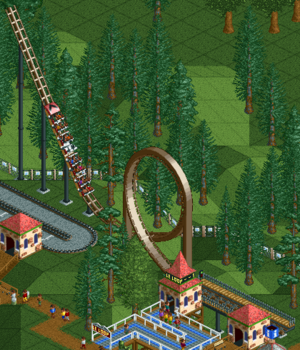
Cost: $3,350 upwards
Max Height: 150 ft (46 m)
Max Track Slope: 60°
Special Pieces: Banked Turns, Boosters, Brakes, Helices, On-Ride Photo, S-Bends, Steep Turns, Vertical Loop
Ride Modes: Continuous Circuit Mode, Powered Launch Mode, Reverse-Incline Launched Shuttle Mode
Appearance: RollerCoaster Tycoon
The most iconic coaster of the bunch, the Steel Roller Coaster is usually one of the first coasters you unlock or have. The track is the standard spine with running rails parallel to it, held by more steel bars and tubular posts. The design of this track allows for a smoother ride than the other steel coasters. The train is a standard shape with a nose that has black V decal at the end. The train can also be facing backwards if you prefer. Like the corkscrew variant, this coaster can also have the Hypercoaster train, but only if the vertical loop is not built.
Despite having only the vertical loop for an inversion, the Steel Coaster is a great addition to the park as its smooth ride allows high excitement but more reasonable intensity and low nausea ratings. It's also a coaster that's very hard to build badly since there aren't as many special pieces to worry about and has a high support limit to allow for more possibilities. You can also create a short shuttle coaster that provides a high guest throughput. The Shuttle Loop design is a very easy coaster design to spam if you're desperate for more guests. Sadly, a station brakes failure has a chance of the train flying back, so if you have space, add a tail end.
Steel Twister Roller Coaster[edit]

Cost: $4,950 upwards
Max Height: 282 ft (86 m)
Max Track Slope: 60°
Special Pieces: Banked Turns, Barrel Roll, Brakes, Half Corkscrew, Half Loop, Helices, In-Line Twist, Large Half Loop, Launched Lift Hill, On-Ride Photo, S-Bends, Steep Turns, Vertical Loop
Ride Modes: Continuous Circuit Mode
Appearance: Corkscrew Follies
The Steel Twister Roller Coaster is the ride with the most special pieces to add. Unfortunately, most levels have those special pieces locked under research. Its track is a tubular steel spine with two running rails like most other steel coasters. The trains have over the shoulder restraints and four car seating that allows for large occupancy. Extra train types include floorless and stand-up variants which increase intensity and nausea. Besides the usual inversions, banked pieces, and on-ride photo section, this coaster uniquely has the launched lift hill that speeds up trains as they ride along it instead of locking them to a set speed.
Out of all the coaster types, the Steel Twister is the most versatile and feature-rich of the bunch. The high support limit allows for very large and steep drops, the launched lift hill can make the ride go much faster and the great number of inversions can allow for some very creative designs. With great construction, you could reach excitement levels to 7. The only downsides are its exorbitant cost and the lack of boosters (unless you use OpenRCT2), but if you're flush with cash, it's a great coaster to recommend.
Steel Wild Mouse Roller Coaster[edit]
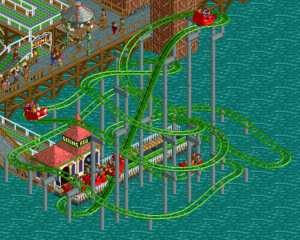
Cost: $1,640 upwards
Max Height: 68 ft (21 m)
Max Track Slope: 60°
Special Pieces: Brakes
Ride Modes: Continuous Circuit Mode
Appearance: Corkscrew Follies
One of the three wild mouse coasters in the game, the Steel Wild Mouse is a compact coaster with tiny turns and steep lift hills available. The tiny steel rail track allows for the four-person mouse cars to have the smoothest ride of the wild mouse trio. It also has brakes for when the cars go much too fast to handle.
Always have tight turns and sudden drops for this ride as they'll need a good amount of G-forces to impress rides. Always have at least one large drop to achieve the speeds necessary, but use brakes if the turns taken are too fast. The smooth ride, 4-person cars, and cheap construction cost makes this coaster the best of the three, but like other wild mouse rides, it can be easy to overboard on G-forces and make a rough ride, so plan carefully.
Suspended Looping Coaster[edit]

Cost: $3,750 upwards
Max Height: 118 ft (36 m)
Max Track Slope: 60°
Special Pieces: Banked Turns, Brakes, Half Corkscrew, Half Loop, Helices, In-Line Twist, On-Ride Photo, S-Bends, Steep Turns, Vertical Loop
Ride Modes: Continuous Circuit Mode, Reverse-Incline Launched Shuttle Mode
Appearance: RollerCoaster Tycoon
This coaster has track similar to the Corkscrew Coaster with a tubular steel spine and two running rails. The trains are below the track instead of above it with over the shoulder restraints and no floor to let the guests dangle their legs below. There is also an alternate face-off train where riders face each other; it can add excitement, but it's also larger than the default train. Unlike the other two suspended coasters, there are inversions available as well as S-bends and brakes. The whole package makes the coaster feel like a smaller Inverted Roller Coaster.
This coaster is very good to build compactly thanks to the large number of inversions and turns it has and can give stats comparable to the Inverted Coaster while being a slightly cheaper option. However, being a suspended-type coaster, it needs three tiles of clearance instead of two, so it can be difficult to weave around certain rides and scenery. It also causes a lot of nausea, so have benches and handymen nearby. On a good note, it also provides a shuttle coaster option by reverse-incline launching.
Suspended Roller Coaster[edit]

Cost: $3,550 upwards
Max Height: 105 ft (32 m)
Max Track Slope: 60°
Special Pieces: Brakes, Helices, S-Bends
Ride Modes: Continuous Circuit Mode
Appearance: RollerCoaster Tycoon
The Suspended Roller Coaster is another common coaster you'll find in most levels. It has a thick tubular spine with two running rails lower than the spine. The helix pieces are actually quarter turns instead of half turns, making them slightly deeper. The trains can either be the default boxy design or airplane-themed cars that hang below the track and rock around through every turn. Because of this, this ride produces a lot more lateral G's than some coaster types.
Because of its lack of loops, bulky layout, no banked turns, and three units of clearance instead of two, building a Suspended Roller Coaster can be unwieldy and not very flexible. The trains for this coaster are also rather large as it'll require a station that's ten tiles long before allowing two trains. Basically, this is a coaster that needs a lot of money and breathing room, so if you want to build this over easier coaster types, plan ahead. Also prepare handymen nearby as the lateral G's it requires will ensure high nausea.
Suspended Single-Rail Roller Coaster[edit]
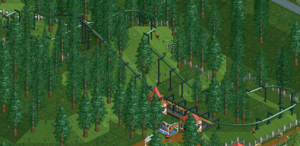
Cost: $1,800 upwards
Max Height: 42 ft (13 m)
Max Track Slope: 25°
Special Pieces: S-Bends
Ride Modes: Continuous Circuit Mode
Appearance: RollerCoaster Tycoon
An incredibly simple design, the Suspended Single-Rail Roller Coaster consists of just that, a track with a single tubular rail held by metal supports. The cars hang from the rail and swing around as soon as they take turns, which means there's no banking. There are also two types of cars: sit-down and lay-down. They both do allow trains instead of singular cars, but not by much as the sit-down ones go up to three cars per train and the lay-down ones go up to two. There's also only one special piece, the S-bend, so no brakes or inversions either.
Like the Single-Rail Roller Coaster, the cars for this coaster are very light. In fact, they're the lightest cars in the game, which means they'll lose speed incredibly quickly after a drop. A guest on the car makes a lot of difference in extra speed, so have "Wait For Full Load" on in the options to ensure empty cars don't collide with full cars. You can mitigate this a bit by having trains instead of singular cars as well. With a three-tile clearance. not very many special pieces, and the lowest support limit of the bunch, this coaster doesn't have a lot of options for varied designs other than the usual big drop after a long chain pull upward. It's only recommended to build this if your options are low.
Vertical Roller Coaster[edit]

Cost: $3,780 upwards
Max Height: 239 ft (73 m)
Max Track Slope: 90°
Special Pieces: Banked Turns, Brakes, Helices, Holding Brake, On-Ride Photo, S-bends, Steep Turns, Vertical Loop
Ride Modes: Continuous Circuit Mode
Appearance: RollerCoaster Tycoon
One of the few coasters that have straight drops, the Vertical Roller Coaster has a square main rail with two running rails parallel and above. The supports are steel and square, below the main rail. The trains have wide, short cars that seat six people with over-the-shoulder restraints, allowing for compact trains. The special pieces allow the vertical loop for inversions (if you have the expansions), a steep lift hill for compactness, and a special holding brake placed just after the crest of a drop, which holds the train for a few seconds before letting it drop down the track for added excitement.
Despite the low amount of inversions, the Vertical Coaster is a great ride to have thanks to its 90-degree drops and small trains that allow for up to 7 trains with 3 cars per train to seat up to 126 people. The track allows for a surprisingly smooth ride despite the over-the-shoulder restraints and using the vertical pieces can keep the ride somewhat compressed. The high support limit also allows for some deep drops, which is useful since vertical pieces require a lot of vertical space. Be careful going wild with those vertical pieces however as they are expensive.
Virginia Reel[edit]
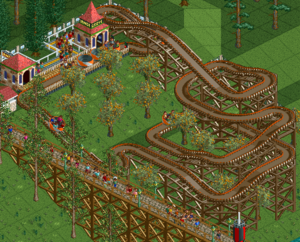
Cost: $975 upwards
Max Height: 59 ft (18 m)
Max Track Slope: 25°
Special Pieces: None
Ride Modes: Continuous Circuit Mode
Appearance: Corkscrew Follies
The only coaster to not have "roller coaster" in the name, the Virginia Reel has a unique looking track, which is a flat, wooden trough with raised sides. The cars are cup-shaped, painted with curved stripes, and keep on the track by those raised sides. Every time they take a turn, they spin. Despite technically being a side-friction coaster, the cars will not fly off the track if they take hills too fast.
Being an old-school ride, the support limit is low and there are no special pieces to work with, but it's also very cheap and surprisingly gets a decent amount of stats for its price. The key to a good Virginia Reel is to make sure those cars spin often, so have lots of turns and hairpins. Be warned that even a small Virginia Reel can have a high nausea rating, so have handymen nearby to take care of the puke.
Wooden Crazy Rodent Roller Coaster[edit]
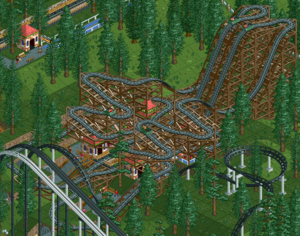
Cost: $1,480 upwards
Max Height: 59 ft (18 m)
Max Track Slope: 60°
Special Pieces: None
Ride Modes: Continuous Circuit Mode
Appearance: RollerCoaster Tycoon
One of the three wild mouse coasters in the game, the Wooden Crazy Roden is a compact coaster with tiny turns and steep lift hills available. The track is laminated wood with a metal top that has holes for the pegs of the cars, which makes said cars tilt slightly when taking turns. There are wild mouse and mine cart cars, the latter being able to make tiny two car trains. Unlike the other two versions, this does not have brakes.
Like the other two, tight turns and large drops are required for good stats, but this coaster type is older than the others and because of that, there are no brakes. It's important to manage speed after a big drop as it's easy to get excess G's and cause the ride to lose excitement. Also, unlike the others, the cars for this ride house two guests instead of four. It's made up by being the cheapest of the Wild Mouse coasters and it still has steep chain lifts, so it's possible to build a great ride out of this, but it may require more coaster building skills than the other two.
Wooden Reverser Roller Coaster[edit]
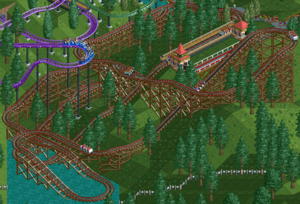
Cost: $1,517 upwards
Max Height: 78 ft (24 m)
Max Track Slope: 25°
Special Pieces: Brakes, Reversing Sections, S-bends
Ride Modes: Continuous Circuit Mode
Appearance: Corkscrew Follies
A side-friction type coaster that has a laminated track with a steel running rail, the Wooden Reverser is not too different from the regular Side-Friction coaster as they both have brakes, S-Bends, and the same track slope and max height. However, the Reverser Coaster has boxy cars that seat six instead of four and has the special reverser piece that flips the car 180 degrees (as long as it doesn't speed past it). Cars are not allowed to enter the station in reverse, so you'll need two reverser pieces to complete the ride.
One other thing it shares with the Side-Friction Coaster is the car's unfortunate tendency to fly off the track if it takes hills too fast. It's important to have a big drop and to not take little hills quickly to avoid crashes. You can use brakes to avoid this as well. Other than that, there's not a lot of special flair that can be added to this coaster, but for its cheap price, it's a decent money maker that usually has middling stats.
Wooden Roller Coaster[edit]
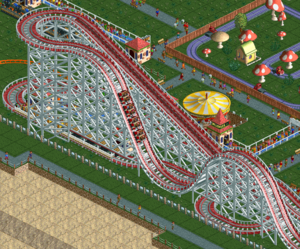
Cost: $2,800 upwards
Max Height: 105 ft (32 m)
Max Track Slope: 60°
Special Pieces: Banked Turns, Brakes, On-Ride Photo, S-Bends, Vertical Loop, Water Splash
Ride Modes: Continuous Circuit Mode
Appearance: RollerCoaster Tycoon
Just as iconic as the Steel Roller Coaster, the Wooden Roller Coaster is a ride you'll usually see available or unlocked early in most levels. It's a noisy, rough-riding coaster that uses laminated wood, steel tracked, and very boxy cars for its trains (which you can flip in reverse). Loopy Landscapes adds a Vertical Loop if you want an inversion, but other special pieces include the On-Ride Photo Section and the Water Splash, which is a long piece of track with a low, water-filled dip that gets riders wet. Be sure to have lots of speed for it as it'll slow down the train significantly.
With a middling cost, great stats, the Wooden Coaster is a very reliable coaster. It's very easy to build since it just requires big drops and banked turns to be fun for your guests. You don't really need the loop or the water splash unless you feel like adding some bonuses to the excitement rating and it can be built as a medium or long ride. If you do decide to build the water splash, it's best to place it near the end of the ride as it doubles as a very effective brake.
Wooden Side-Friction Roller Coaster[edit]

Cost: $1,517 upwards
Max Height: 78 ft (24 m)
Max Track Slope: 25°
Special Pieces: Brakes, S-bends
Ride Modes: Continuous Circuit Mode
Appearance: Corkscrew Follies
One of the oldest coaster types in the game, the Wooden Side-Friction Coaster is a laminated wooden ride with flat steel running rails for cars that hold up to four people and have side-friction wheels. There are brakes to make the ride smoother and S-Bends to help with more precise construction, but this ride has a complete lack of frills otherwise.
One thing to be careful about are the speed of the cars; if they take the top of a hill too quickly, they will fly off the track and land down, exploding and killing anybody on board. To avoid this, test your design more than once, avoid having small hills unless the cars are going very slow, and use brakes. Other than this fatal downside, the Side-Friction Coaster is decent for its low cost and isn't too difficult to build.
Wooden Twister Roller Coaster[edit]

Cost: $2,800 upwards
Max Height: 105 ft (32 m)
Max Track Slope: 60°
Special Pieces: Banked Turns, Brakes, Helices, On-Ride Photo, S-Bends, Steep Turns
Ride Modes: Continuous Circuit Mode
Appearance: Corkscrew Follies
This may look exactly like the Wooden Roller Coaster, but the Wooden Twister Roller Coaster does have some differences. While it also has laminated wood tracks with steel running rails, the cars are shaped a little differently to hold two guests but have longer trains and flanged running wheels. More notably, the banking has been increased from 30 degrees to 50, allowing for more speeds, less G-forces and even steep twists. While you do get helices for this coaster, there's no Water Splash or Vertical Loop.
The Wooden Twister Coaster is just as effective as the original Wooden Coaster as its design allows for a smoother, faster ride as a tradeoff for less special pieces and no inversions. They also reach similar stats on excitement (5-7), intensity (6-8), and nausea (4-6). Add a big drop similar to the Wooden Coaster for Vertical G's and be liberal with the helix pieces for Lateral G's. Make a coil of helices similar to the Mine Train Coaster for an excitement bonus as well as adding small hills along the track. Whether going for the standard or twisted version, you can't go wrong with either.